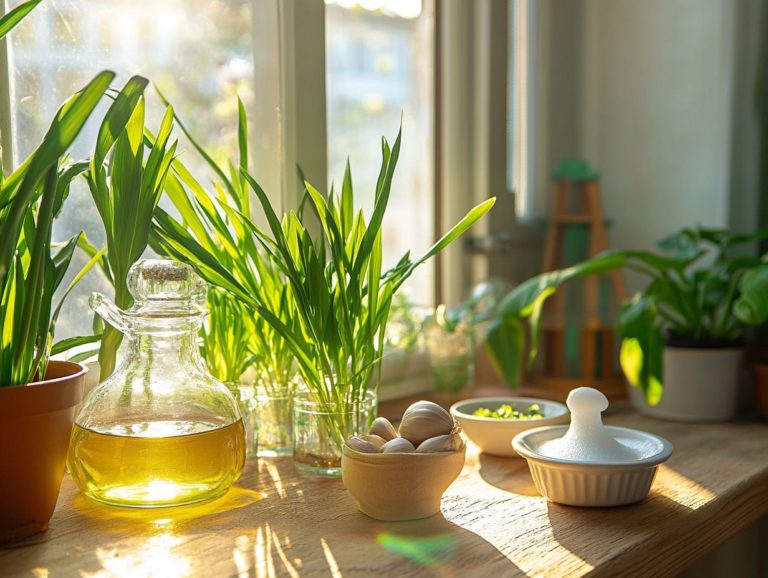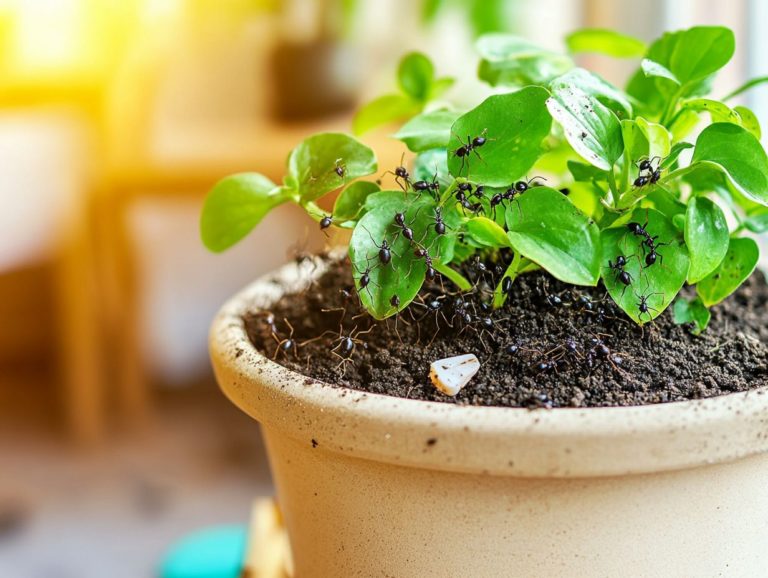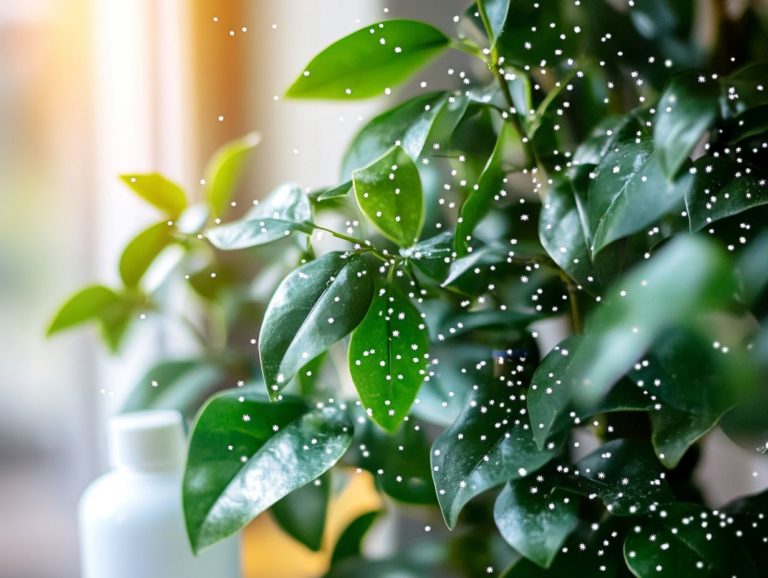How to Encourage Beneficial Insects Indoors
Not all insects are pests; many are actually helpful! Beneficial insects play a crucial role in keeping your indoor space healthy.
These tiny allies not only aid in natural pest control but also enhance plant growth, creating a significant impact in your home.
Discover the fascinating world of beneficial insects and how they can transform your indoor space! You ll also learn effective, non-toxic methods for managing harmful insects, ensuring your living area remains harmonious and inviting.
Contents
- Key Takeaways:
- Benefits of Having Beneficial Insects Indoors
- Common Types of Beneficial Insects
- How to Attract Beneficial Insects Indoors
- Dealing with Harmful Insects Indoors
- Frequently Asked Questions
- What are beneficial insects and why should I encourage them indoors?
- How can I attract beneficial insects indoors?
- What types of plants should I include in my indoor garden to attract beneficial insects?
- Can I use insecticides or pesticides to control beneficial insects indoors?
- How can I prevent harmful insects from entering my indoor garden?
- What are some other ways to encourage beneficial insects indoors?
Key Takeaways:
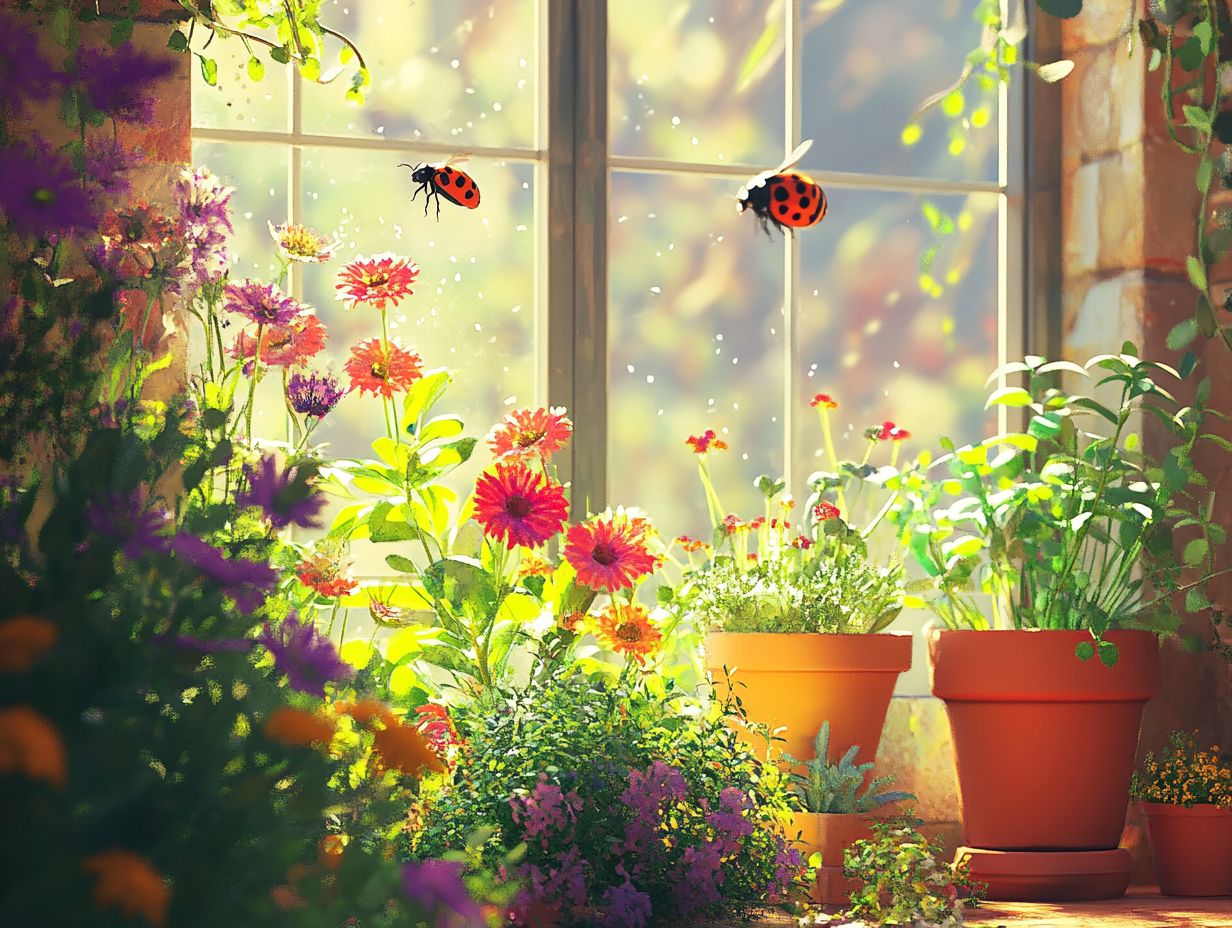
- Plant flowers and herbs that welcome beneficial insects into your home!
- Invite beneficial insects to control pests and boost your indoor ecosystem.
- Welcome beneficial insects to help you safely manage pests without chemicals.
What are Beneficial Insects?
Beneficial insects include various helpful species that play an essential role in keeping your gardens and indoor spaces thriving by managing pests and enhancing biodiversity.
Take ladybugs, for example. They eat a lot of aphids! Lacewings are also known for their relentless appetite for mealybugs and other soft-bodied nuisances. Then there are wasps that help control pests, which lay their eggs on host pests, providing a natural way of managing pest populations.
The presence of these tiny allies not only curbs pest populations but also boosts overall ecosystem health, fostering pollination and nutrient cycling.
By promoting biodiversity through a variety of plant species, you attract these helpful insects to both indoor and outdoor settings. This creates a balanced habitat that leads to more resilient plant growth and vibrant environmental interactions.
Benefits of Having Beneficial Insects Indoors
Bringing beneficial insects into your home offers amazing benefits for plants and people alike! These natural predators work hard to keep pests at bay think aphids, mealybugs, and thrips reducing the need for chemical treatments while enhancing the overall health of your indoor plants.
Their presence also enriches the biodiversity of your indoor ecosystem, creating a balanced environment that supports robust plant growth and development.
How They Can Help with Pest Control
Beneficial insects are your essential allies in the battle against pests, as they actively target and manage populations of invasive nuisances like aphids, mealybugs, and spider mites through natural hunting. By introducing species such as ladybird beetles, green lacewings, and parasitic wasps, you can create an effective, organic pest management strategy that promotes plant health without harmful chemicals. These techniques not only protect your indoor plants but also support beneficial insect populations.
To make the most of these beneficial insects, monitor pest populations and identify the specific invaders in your garden. You ll often find aphids clustering on new plant growth, leaving behind a sticky residue, while spider mites prefer the undersides of leaves, where they weave fine webbing.
By recognizing these signs, you can introduce the right predators at the optimal time.
- Ladybird beetles are great at eating large numbers of aphids.
- Green lacewing larvae are voracious feeders, tackling both aphids and caterpillars with gusto.
Utilizing these natural allies not only minimizes your reliance on chemicals but also fosters a healthier, more balanced garden environment.
Contribution to Indoor Ecosystems
Beneficial insects play an invaluable role in your indoor ecosystem. They manage pest populations and enhance biodiversity, promoting a healthier environment for your plants.
Attracting beneficial insects like ladybird beetles and lacewings can lead to a balanced ecosystem. This significantly reduces pest infestations and improves the health of your houseplants.
When these insects take residence, they play crucial roles in pollination and natural pest control. They serve as a line of defense against harmful species such as aphids and spider mites.
For instance, minute pirate bugs are known to feast on a variety of pests, effectively keeping their populations in check. Their presence also aids in nutrient cycling, as they contribute to the organic matter in your soil.
By nurturing beneficial insects, you create a thriving habitat and foster a vibrant ecosystem that promotes resilience and sustainability in your green spaces.
Common Types of Beneficial Insects

Several common types of beneficial insects exist, each fulfilling a distinct role in fostering biodiversity and managing pest populations within your indoor spaces. Species like ladybird beetles, green lacewings, and various parasitic wasps are celebrated for their exceptional ability to keep pests such as aphids, mealybugs, and spider mites in check.
By understanding these beneficial insects, you not only enhance your pest control strategies but also promote the overall health of your houseplants. This contributes to a vibrant and thriving indoor ecosystem.
Identification and Characteristics
Identifying beneficial insects is essential for effective pest management. You can achieve this by understanding their unique characteristics and behaviors.
Take ladybird beetles, for instance. Their vibrant red or orange bodies, adorned with striking black spots, not only catch the eye but also reveal their identity as agile hunters of aphids, those pesky plant pests.
Then there are the green lacewings, whose delicate, lacy wings hint at a fascinating life cycle. Their predatory larvae actively seek out mealybugs and spider mites, ensuring these nuisances don t take over your garden or home.
Being able to differentiate these beneficial insects from their harmful counterparts often characterized by duller colors or more aggressive behavior is crucial for maintaining a balanced ecosystem. By educating yourself about these traits and behaviors, you reinforce the significant role these insects play in integrated pest management strategies.
This balanced approach helps pave the way for a healthier indoor environment without the need for chemical pesticides.
How to Attract Beneficial Insects Indoors
Attracting beneficial insects indoors is a refined strategy that enhances biodiversity and promotes natural pest control, safeguarding the health of your houseplants.
To create an inviting environment, consider incorporating specific plants and food sources tailored to the needs of beneficial species like ladybird beetles and lacewings. These insects flourish on a diverse diet that includes aphids and nectar.
By cultivating an atmosphere that welcomes these helpful insects, your indoor garden can transform into a sanctuary, supporting both your plants and the essential creatures that nurture them. For more insights, learn how to foster a pest-resistant indoor environment.
Creating a Suitable Environment
To create an ideal environment for beneficial insects indoors, select the right plants and strategies. Incorporating flowering plants like African blue basil and various herbs provides essential nectar sources for pollinators and beneficial predators. This helps cultivate a vibrant ecosystem right in your home.
Prioritizing biodiversity is key. It will effectively attract and retain these valuable allies in your pest control efforts. The layout of your indoor garden is also crucial. Grouping plants together enhances visual appeal and offers shelter and moisture, creating a microclimate that encourages insect activity.
Actively maintaining your plants is essential for a thriving indoor garden! Steering clear of artificial chemicals used to kill pests in favor of organic alternatives allows beneficial insects to thrive without threats. A diverse range of plant species attracts a wider array of insects, strengthening your indoor ecosystem’s resilience.
Plants and Foods that Attract Them
Choose the right plants and foods to attract beneficial insects and foster a vibrant indoor ecosystem.
Plants like African blue basil, marigolds, and dill not only look good but also nurture populations of beneficial insects. These species are vital for effective natural pest management, as they produce nectar and pollen that attract beneficial species like hoverflies and parasitic wasps.
Incorporating plants like yarrow and fennel further diversifies your indoor ecosystem. This enhances biodiversity and creates a balanced environment, keeping pests in check naturally and significantly reducing the need for chemical interventions.
Dealing with Harmful Insects Indoors
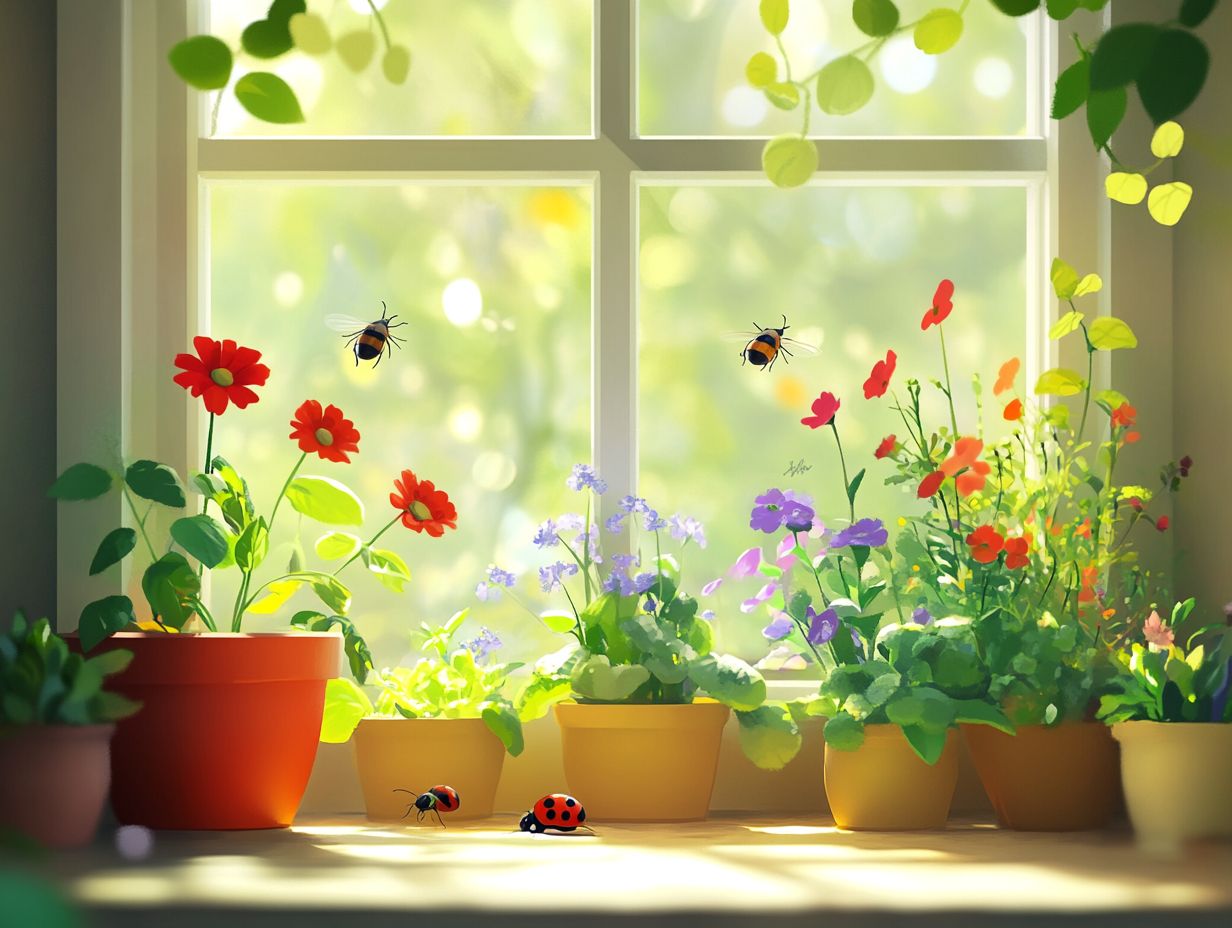
Managing unwanted insects indoors can be frustrating, but you can make a difference with effective control strategies. Blend preventive measures with the assistance of beneficial insects.
Common indoor pests like aphids, mealybugs, and spider mites can be managed through a thoughtful mix of non-toxic methods and the introduction of natural predators. This approach reduces pest populations while promoting plant health and enhancing your overall ecosystem’s stability.
Non-Toxic Ways to Remove Pests
You have non-toxic methods to remove pests indoors without harming beneficial insects.
By using organic sprays like neem oil or insecticidal soap, you can target pesky insects safely. Sprinkling diatomaceous earth in affected areas works wonders by dehydrating insects without impacting beneficial species. Using traps like yellow sticky cards helps monitor and reduce pest populations while keeping helpful insects safe.
This commitment to organic solutions not only assists in pest management but also fosters a balanced indoor ecosystem that thrives.
Benefits of Coexisting with Beneficial Insects
Coexisting with beneficial insects indoors offers many advantages for your plants, pest management, and overall biodiversity. By nurturing an environment where species like green lacewings and ladybird beetles thrive, you can naturally keep harmful pests at bay while boosting your plants’ vitality. This mutual benefit strengthens the local ecosystem and promotes a sustainable approach to indoor gardening!
Encouraging these insects reduces reliance on chemical pesticides, which can be risky for both human health and the environment. For example, ladybird beetles act as nature s aphid assassins, keeping their populations in check. Green lacewings also actively consume various pests, ensuring that your plants receive essential nutrients without interference from harmful invaders.
Fostering a diverse insect population helps cultivate a balanced indoor ecosystem that builds resilience against future infestations. This creates a healthier space and makes your indoor environment more vibrant and visually appealing!
Frequently Asked Questions
What are beneficial insects and why should I encourage them indoors?
Beneficial insects play a key role in pollination, pest control, and overall ecosystem health. Encouraging them indoors helps maintain a healthy and balanced environment without harmful chemicals.
How can I attract beneficial insects indoors?
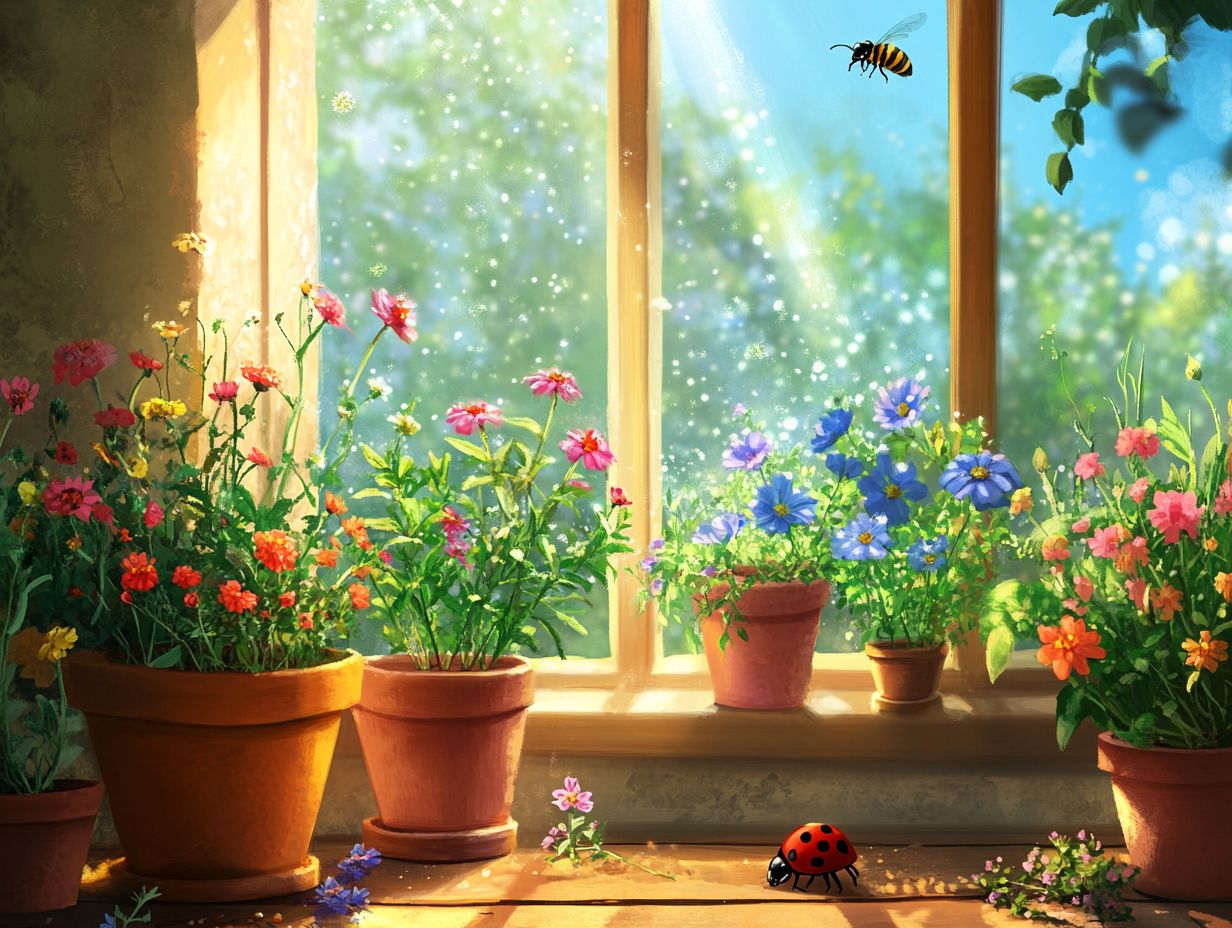
To attract beneficial insects indoors, provide them with a suitable habitat. This includes plants that offer nectar, shelter, and food sources.
What types of plants should I include in my indoor garden to attract beneficial insects?
- Dill
- Fennel
- Marigolds
- Lavender
Research which plants are native to your area and can thrive indoors to attract a diverse range of beneficial insects!
Can I use insecticides or pesticides to control beneficial insects indoors?
No, insecticides or pesticides should not be used to control beneficial insects indoors as they can harm these helpful creatures. Focus on creating a healthy and diverse ecosystem to naturally control pest populations.
How can I prevent harmful insects from entering my indoor garden?
Regularly inspecting and cleaning your plants can help prevent harmful insects from entering your indoor garden. Removing any dead or decaying plant material deters pests and protects your beneficial insects!
What are some other ways to encourage beneficial insects indoors?
In addition to providing suitable habitats and plants, use companion planting techniques! Plant certain species together to attract beneficial insects and repel harmful ones. You can also install insect houses or create small ponds or water sources for these helpful insects to thrive.


